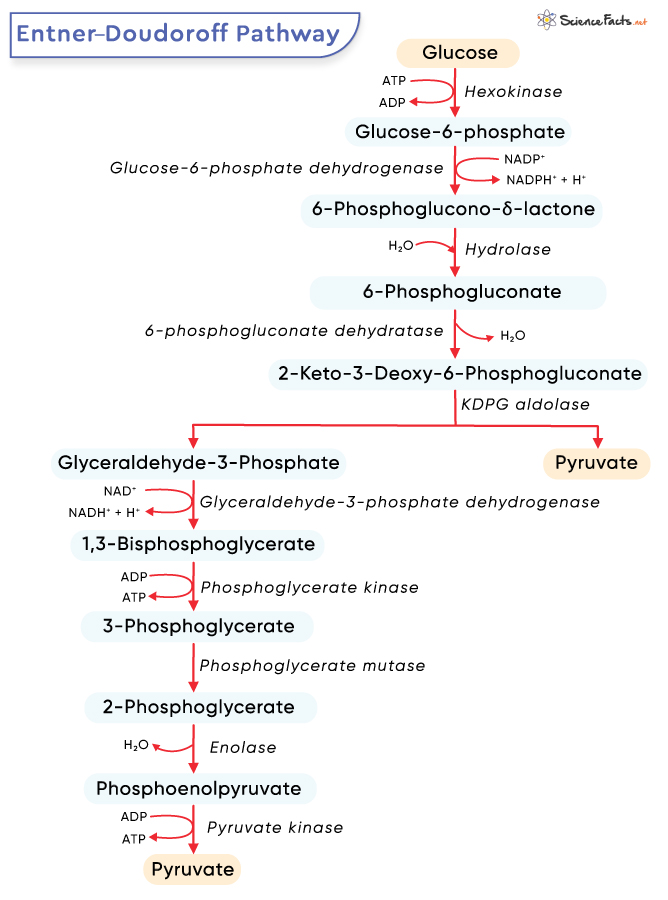It was first reported in 1952 by Michael Doudoroff and Nathan Entner in the bacterium Pseudomonas saccharophila.
Where is the Entner-Doudoroff Pathway Found
Steps of the Entner-Doudoroff Pathway
Products of the Entner-Doudoroff Pathway
Embden Meyerhof Pathway vs. Entner Doudoroff Pathway
Some microorganisms carrying out the ED pathway are Pseudomonas, Azotobacter, Rhizobium, Agrobacterium, Escherichia coli, Enterococcus fecalis, Zymononas mobilies, and Xanthomonas campestries. These bacteria are aerobes due to the low ATP yield per glucose. The first step of the ED pathway involves the phosphorylation of glucose by hexokinase to form glucose 6-phosphate (G6P). Step 2: Glucose-6-Phosphate to 6-Phosphogluconolactone The G6P is then converted to 6-phosphogluconolactone by the enzyme glucose-6-phosphate dehydrogenase. This step requires the presence of the coenzyme NADP+ forming NADH along with a free hydrogen atom H+. Step 3: 6-Phosphogluconolactone to 6-Phosphogluconic Acid (6PGL) The 6PGL forms 6-phosphogluconic acid in the presence of enzyme hydrolase. Step 4: 6-Phosphogluconic acid (6PGL) to 2-Keto-3-Deoxy-6-Phosphogluconate (KDPG) The 6-phosphogluconic acid is further converted to 2-keto-3-deoxy-6-phosphogluconate (KDPG) by the enzyme 6-phosphogluconate dehydratase. Step 5: 2-Keto-3-Deoxy-6-Phosphogluconate to Pyruvate and Glyceraldehyde-3-Phosphate The KDPG forms pyruvate and glyceraldehyde-3-phosphate in the presence of the enzyme KDPG aldolase. The pyruvate formed then enters the Citric acid cycle or electron transport chain. However, the other product, glyceraldehyde-3-phosphate, further enters the glycolysis pathway forming pyruvate following subsequent steps. Step 6: Glyceraldehyde-3-Phosphate to 1,3-Bisphosphoglycerate The glyceraldehyde-3-phosphate is converted to 1,3-bisphosphoglycerate by the enzyme glyceraldehyde-3-phosphate dehydrogenase. In this step, two molecules of NAD+ are converted to two molecules of NADH and two H+. Step 7: 1,3-Bisphosphoglycerate to 3-Phosphoglycerate In this step, a phosphate group is transferred from 1,3-bisphosphoglycerate to ADP by the enzyme phosphoglycerate kinase forming ATP and 3-phosphoglycerate. This step acts as one of the regulatory steps of the pathway. Step 8: 3-Phosphoglycerate to 2-Phosphoglycerate This step is a rearrangement reaction where 3-phosphoglycerate is converted to 2-phosphoglycerate by the enzyme of phosphoglycerate mutase. Step 8: 2-Phosphoglycerate to Phosphoenolpyruvate 2-phosphoglycerate is converted to phosphoenolpyruvate by the enzyme enolase. Step 9: Phosphoenol Pyruvate to Pyruvate It is the final step, where phosphoenolpyruvate is converted to pyruvate and a molecule of ATP as substrate-level phosphorylation using the enzyme pyruvate kinase. It is an additional regulatory step of the pathway.
